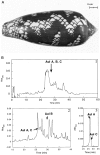alpha-conotoxin AuIB selectively blocks alpha3 beta4 nicotinic acetylcholine receptors and nicotine-evoked norepinephrine release
- PMID: 9786965
- PMCID: PMC6793526
- DOI: 10.1523/JNEUROSCI.18-21-08571.1998
alpha-conotoxin AuIB selectively blocks alpha3 beta4 nicotinic acetylcholine receptors and nicotine-evoked norepinephrine release
Abstract
Neuronal nicotinic acetylcholine receptors (nAChRs) with putative alpha3 beta4-subunits have been implicated in the mediation of signaling in various systems, including ganglionic transmission peripherally and nicotine-evoked neurotransmitter release centrally. However, progress in the characterization of these receptors has been hampered by a lack of alpha3 beta4-selective ligands. In this report, we describe the purification and characterization of an alpha3 beta4 nAChR antagonist, alpha-conotoxin AuIB, from the venom of the "court cone," Conus aulicus. We also describe the total chemical synthesis of this and two related peptides that were also isolated from the venom. alpha-Conotoxin AuIB blocks alpha3 beta4 nAChRs expressed in Xenopus oocytes with an IC50 of 0.75 microM, a kon of 1.4 x 10(6) min-1 M-1, a koff of 0.48 min-1, and a Kd of 0.5 microM. Furthermore, alpha-conotoxin AuIB blocks the alpha3 beta4 receptor with >100-fold higher potency than other receptor subunit combinations, including alpha2 beta2, alpha2 beta4, alpha3 beta2, alpha4 beta2, alpha4 beta4, and alpha1 beta1 gamma delta. Thus, AuIB is a novel, selective probe for alpha3 beta4 nAChRs. AuIB (1-5 microM) blocks 20-35% of the nicotine-stimulated norepinephrine release from rat hippocampal synaptosomes, whereas nicotine-evoked dopamine release from striatal synaptosomes is not affected. Conversely, the alpha3 beta2-specific alpha-conotoxin MII (100 nM) blocks 33% of striatal dopamine release but not hippocampal norepinephrine release. This suggests that in the respective systems, alpha3 beta4-containing nAChRs mediate norepinephrine release, whereas alpha3 beta2-containing receptors mediate dopamine release.
Figures





Similar articles
-
Alpha-conotoxin MII blocks nicotine-stimulated dopamine release in rat striatal synaptosomes.J Neurosci. 1997 Jul 15;17(14):5263-70. doi: 10.1523/JNEUROSCI.17-14-05263.1997. J Neurosci. 1997. PMID: 9204910 Free PMC article.
-
UB-165: a novel nicotinic agonist with subtype selectivity implicates the alpha4beta2* subtype in the modulation of dopamine release from rat striatal synaptosomes.J Neurosci. 2000 Apr 15;20(8):2783-91. doi: 10.1523/JNEUROSCI.20-08-02783.2000. J Neurosci. 2000. PMID: 10751429 Free PMC article.
-
Characterization of nicotinic acetylcholine receptors that modulate nicotine-evoked [3H]norepinephrine release from mouse hippocampal synaptosomes.Mol Pharmacol. 2006 Sep;70(3):967-76. doi: 10.1124/mol.106.024513. Epub 2006 May 30. Mol Pharmacol. 2006. PMID: 16735605
-
Neuronal Nicotinic Acetylcholine Receptor Modulators from Cone Snails.Mar Drugs. 2018 Jun 13;16(6):208. doi: 10.3390/md16060208. Mar Drugs. 2018. PMID: 29899286 Free PMC article. Review.
-
The subtypes of nicotinic acetylcholine receptors on dopaminergic terminals of mouse striatum.Biochem Pharmacol. 2007 Oct 15;74(8):1235-46. doi: 10.1016/j.bcp.2007.07.032. Epub 2007 Jul 27. Biochem Pharmacol. 2007. PMID: 17825262 Free PMC article. Review.
Cited by
-
The α3β4* nicotinic acetylcholine receptor subtype mediates nicotine reward and physical nicotine withdrawal signs independently of the α5 subunit in the mouse.Neuropharmacology. 2013 Jul;70:228-35. doi: 10.1016/j.neuropharm.2013.01.017. Epub 2013 Feb 13. Neuropharmacology. 2013. PMID: 23416040 Free PMC article.
-
Reduction of neuromuscular activity is required for the rescue of motoneurons from naturally occurring cell death by nicotinic-blocking agents.J Neurosci. 2000 Aug 15;20(16):6117-24. doi: 10.1523/JNEUROSCI.20-16-06117.2000. J Neurosci. 2000. PMID: 10934261 Free PMC article.
-
Vulnerability of 125I-alpha-conotoxin MII binding sites to nigrostriatal damage in monkey.J Neurosci. 2001 Aug 1;21(15):5494-500. doi: 10.1523/JNEUROSCI.21-15-05494.2001. J Neurosci. 2001. PMID: 11466420 Free PMC article.
-
Ligands selective for alpha4beta2 but not alpha3beta4 or alpha7 nicotinic receptors generalise to the nicotine discriminative stimulus in the rat.Psychopharmacology (Berl). 2007 Feb;190(2):157-70. doi: 10.1007/s00213-006-0596-8. Epub 2006 Nov 18. Psychopharmacology (Berl). 2007. PMID: 17115136
-
Structure of alpha-conotoxin BuIA: influences of disulfide connectivity on structural dynamics.BMC Struct Biol. 2007 Apr 20;7:28. doi: 10.1186/1472-6807-7-28. BMC Struct Biol. 2007. PMID: 17445276 Free PMC article.
References
-
- Cartier GE, Yoshikami D, Gray WR, Luo S, Olivera BM, McIntosh JM. A new α-conotoxin which targets α3β2 nicotinic acetylcholine receptors. J Biol Chem. 1996a;271:7522–7528. - PubMed
-
- Cartier GE, Yoshikami D, Luo S, Olivera BM, McIntosh JM. α-Conotoxin MII (α-CTx-MII) interaction with neuronal nicotinic acetylcholine receptors. Soc Neurosci Abstr. 1996b;22:268.
-
- Conroy WG, Berg DK. Neurons can maintain multiple classes of nicotinic acetylcholine receptors distinguished by different subunit compositions. J Biol Chem. 1995;270:4424–4431. - PubMed
Publication types
MeSH terms
Substances
Grants and funding
LinkOut - more resources
Full Text Sources
Other Literature Sources
Miscellaneous
